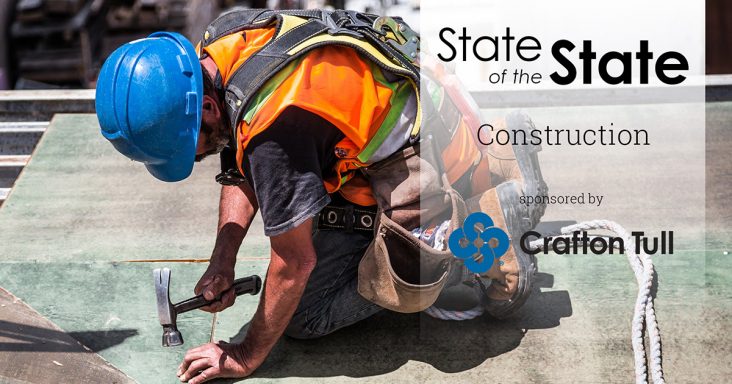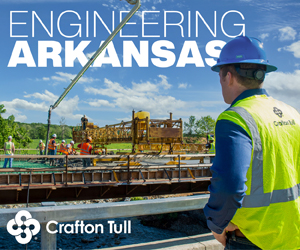Housing construction strong, but work-from-home trend likely to reduce commercial work
by January 7, 2021 10:45 am 1,050 views

Baldwin & Shell Construction Company President and CEO Scott Copas has navigated tough economic times before. In the past when there was a downturn in the economy, his company would focus on church construction and renovation projects. It seemed like people turned to churches in lean economic times.
COVID-19 has completely changed that dynamic because of the social distancing requirements, Copas told Talk Business & Politics. The pandemic will likely lead to a slowdown of some traditional forms of commercial buildings such as office and retail space, but Copas is hopeful others, such as hospital and medical space, will continue to grow.
Virtual learning and working from home will probably be permanent changes as the new decade continues to unfold, and Copas is concerned what impact that could have.
“It’s a major concern … that’s for sure,” he said.
As 2021 gets underway, Copas believes certain sectors of commercial construction will continue to perform well. Public school building projects, those relating to the medical field, entertainment and sports venues, and targeted retail and restaurants should thrive once the pandemic is under control, he said. Building projects on college campuses, office space construction, and big box retail are likely to decline, he added.
Geography in the Natural State plays a role in the number of commercial construction projects. Northwest Arkansas continues to boom with projects, to the point that his company is back-logged, Copas said.
“Northwest Arkansas — it didn’t slow down,” he said.

Northeast Arkansas, centered around the Jonesboro area, has been relatively flat from a commercial perspective. But Copas thinks the Memphis area, which adjoins several counties in the Arkansas Delta and is a short-drive from Jonesboro, is about to experience major growth. Downtown Memphis is widespread with new development. In the coming years, Copas thinks several cities in Arkansas such as Hot Springs, Bryant and Benton have the potential to grow.
Nabholtz CEO Greg Williams told Talk Business & Politics assessments of the commercial construction market heading into the new year are more volatile, but residential projects have gained enormously. Growth in central Arkansas for his company has been slow, and growth in Northwest Arkansas has remained consistent, he said. Big box retail and restaurants have been hit hard by the pandemic, but warehouse space and data centers have been in demand.
“I would say overall the market is fairly good, but we do have some challenges out there,” he said. “Generally, we’re optimistic.”
One sector generating optimism is the residential sector. Interest rates have remained historically low, and many people have been spending less money on vacations and entertainment and that has led to a housing market surge, he said. Housing inventories in some cities have remained near all-time lows. Many are selling before they are completed or hit the market, he said. The market has been so good that common items such as appliances, doors, windows, and others are often hard to find, Williams said.
“Jonesboro has been a bright spot economically,” he said. “We’re are happy to have a presence there.”
Williams concurred with Copas that changes in the office space, education, medical facility sectors are inevitable. People are learning how to live and work more from home, and it will have long-term impacts to the commercial construction industry, he added.
Associated Builders and Contractors’ chief economist Anirban Basu forecasts a recession threat for the construction sector next year, but he outlined some potential economic bright spots, such as e-commerce and Class B office space, he said. Although ABC’s Construction Backlog Indicator – a leading indicator that reflects projects under contract yet to be executed – rebounded to 7.7 months in October, an increase of 0.2 months from September 2020’s reading, and although construction had added 689,000 jobs by September (after a loss of 1.1 million in March and April), Basu said another surge of case numbers will likely result in a “W” shaped recovery.
“Another recession may be on the horizon,” Basu said. “Critically, one could occur even if a further stimulus is passed. Stimulus supports the demand side of the economy, primarily. Another shutdown would compromise the economy’s ability to produce (supply side), presumably leading to another round of mass layoffs, job losses, crumbling consumer confidence, corporate bankruptcies and other negative outcomes. If the first recession is any indication, the next one will be sharp and short. Regardless, that would delay complete recovery, which is the ultimate aspiration.”
These factors have pushed nonresidential construction to the brink. Commercial real estate, especially Class A office spaces needs have cratered after many professionals have opted to work from their homes, he said. In fact, the negation of commutes, childcare concerns and office distractions have meant that 37% of workers now complete their jobs entirely from home.
